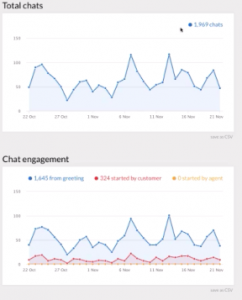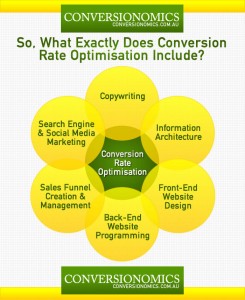— December 19, 2018

Thought leadership strategy is like climbing a mountain. There’s no shortcuts. It takes a lot of time and effort to work your way to the top, but once you’re there, you have an amazing view. Plus, you have the advantage of towering over your competitors.
But how can you know whether thought leadership is worth the time and effort involved?
A recent study from Edelman and LinkedIn may help you to see why so many B2B brands are using thought leadership to shore up their strategy. These two brands have joined forces to create the 2019 B2B Thought Leadership Impact Study. This study reveals:
- The power that thought leadership wields over both marketing and sales.
- How senior decision makers view thought leadership.
- How people interact with thought leadership content.
- What kind of thought leadership matters to B2B audiences.
What Does Thought Leadership Mean?
People use the term thought leadership to mean a few different things, so let’s first clarify the thought leadership meaning this study uses. According to the study, thought leadership refers to “free deliverables that organizations or individuals produce on a topic in their area of expertise, when they feel others can benefit from their expertise.”
Note, however, that in terms of this study, thought leadership does not include self-promotional content, which only serves the purpose of describing an organization or its products or services.
Many businesses do not see the true value of thought leadership content, according to the study.
This means that even if they do have a strategy in place to grow thought leadership, they may not put in the time and effort needed for this strategy to bear fruit.
So why should you dedicate your resources to a thought leadership marketing strategy?
The Thought Leadership Divide
The study uncovered a large disconnect between how buyers and sellers view thought leadership. While 87% of business decision makers say thought leadership increases an organization’s trust factor, only 49% of sellers agreed. Similarly, 89% of buyers say thought leadership enhances a brand’s reputation while only 55% of sellers concur.
The disconnect extended through all parts of the sales process — from awareness to consideration to purchase to cross sell.
“B2B buyers say thought leadership has more influence on their purchase behaviors across every stage of the buying process than marketers and sellers believe. This means that many marketers are likely engaged in activity that is underutilized or worse, actually detrimental to sales efforts. Companies need to scrutinize and better align internally around the “why and how” of their own thought leadership to fully harness its potential and ensure that, at minimum, it’s not harming their reputation and sales.”
— Joe Kingsbury, U.S. Managing Director, B2B at Edelman
Why Thought Leadership Marketing Is Vital to Your B2B Strategy
For years we’ve promoted thought leadership as an important and necessary strategy for B2B brands — but this study shows just how important it is.
58% of business decision makers said that thought leadership material was directly responsible for their awarding business to one organization over another. And 61% of C-suite executives were willing to pay a higher premium to do business with established thought leaders over their non-thought leader competitors.
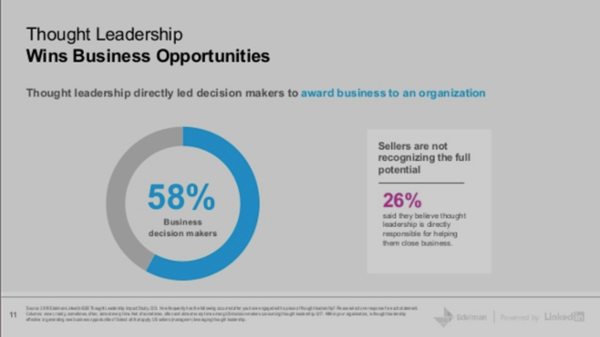
Another 45% of decision makers, upon reading thought leadership material, invited organizations to bid on a project even though they were previously not considering the brand.
These numbers speak to the power of thought leadership — not only as a reputation builder, but also as a way to grow your bottom line.
How can you improve your brand’s thought leadership strategy? What do B2B businesses want to see in thought leaders? Let’s look at this Edelman-LinkedIn report in more detail and see what tactics you can use to boost your own thought leadership.
8 Ways to Strengthen Your Thought Leadership Strategy
1. Create High Quality Content
The biggest factor that can impact your thought leadership goals is the quality of your content. Business decision makers said that 30% of the content they came across was either poor or mediocre, and an additional 53% rated the content as merely good.
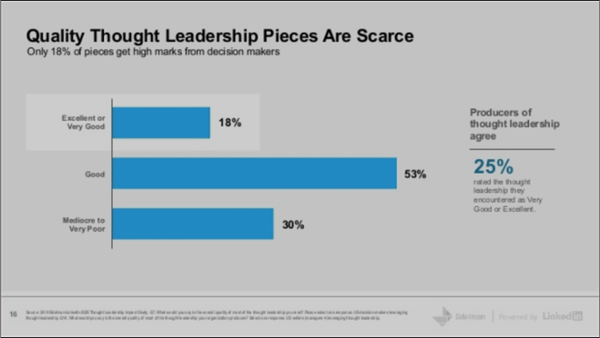
In another study conducted by Velocity Partners, 57% of businesses surveyed viewed the content sent to them as useless. Another 66% said that they received too much content from businesses.
Look at this as an opportunity. Put your time and resources into creating top-quality content that leaves your audience wanting more. This includes long-form blog posts, ebooks, checklists, infographics, videos and you name it. Ensure that all your content is of professional quality, both in appearance and content. And be careful not to bombard and overwhelm your audience with too much content — even if it is of top quality.
2. Address the Entire Sales Funnel
Thought leadership is a multi-layered tool that many marketers do not use to its full potential. Many use it for the top of the funnel, to gain their audience’s interest and appreciation. But when we move down to the bottom of the funnel, we see a hole that thought leadership can fill.
As people are nearing the end of their decision-making process, more in-depth thought leadership pieces can help them to make up their mind — and may help them to favor your brand over others.
3. Take the Front Seat of the Conversation
When asked in the Edelman-LinkedIn study how they viewed thought leadership material, 60% of respondents said a lot of it lacked valuable insight.
Look at your industry for areas where you can provide a fresh voice. Share insights that show how well you know your industry and will help your audience make the best decisions. You need to be leading the conversation — don’t merely comment on what other industry experts say.
4. Weed Out the Bad Thought Leadership Content
Thought leadership is a double-edged sword. Done poorly, it can harm a business. For instance, while 92% of those surveyed in the Edelman-LinkedIn study said that their respect for an organization increased because of thought leadership material, 46% of respondents said it had decreased.
Similarly, while 75% of business leaders will follow someone based on their thought leadership material, 60% said that they would stop following someone after reading their thought leadership pieces.
And even more telling, while 58% decided to award business based on thought leadership, 29% decided not to based on thought leadership content.
What do these red flags tell us? While thought leadership is an effective and important strategy, if done poorly, it can have a destructive impact on your brand.
What can you do to ensure that your thought leadership content passes the test and positively impacts your audience? Be purposeful with your creation of thought leadership material. Identify the needs of your audience and seek to address those in your content. Make every piece of content you create easy for anyone in your audience to understand, digest and value.

5. Keep Your Content Relevant
Your content needs to be on point for your audience. It could be the most interesting, well-written content, but if your audience isn’t hungry for it, it won’t matter.
The Edelman-LinkedIn study revealed that a key factor to getting people to engage with content is choosing topics that impact their business. This means keeping your ears to ground, so to speak, to find out what interests your audience.
Look to social media research, paid services like BuzzSumo, and listening to the concerns of current customers to fill in any gaps in your knowledge of what your audience needs.
6. Lay Out Your Vision
Business decision makers like assurances — and when you have a vision statement that clearly articulates your vision for today and tomorrow, it instills confidence. This point is underscored in the survey. Nearly 9 out of every 10 respondents (88%) said it’s important for companies to have a clear vision of the future.
If you don’t already have a vision statement, it’s time to create one. Think about what values guide you toward your goals. This should not be a run-of-the-mill answer. Be creative and purposeful — it should capture the attention of your audience, but also convey sincerity.
7. Build A Foundation of Trust
Never underestimate the power of trust. In our advertising-infused culture, people feel betrayed by advertising and marketing — and more weary than ever about doing business with people they don’t know. For example, 82% of business decision makers surveyed in the Edelman-LinkedIn survey said they prefer content that is shared by someone they know and respect.
How should this affect your thought leadership marketing? Tap into the power of word of mouth marketing and other tactics that can help your thought leadership material succeed.
Make it easy for people to share your content with easy-to-see share buttons. Consider creating a rewards program that encourages audiences to share your content. Seek opportunities to post your content on influential sites.
8. Be Concise
More isn’t always better. And long-winded isn’t a sign of industry expertise. In fact, the best way to showcase your thought leadership is with succinct, to the point content.
While long-form content such as ebooks and white papers do have a place in your strategy, it should not be your only strategy. Over half (57%) of business decision makers showed a preference for what is referred to as “snackable” media formats — in other words, media that they can read within a few minutes.
Look at ways to create infographics, videos, and blog posts that are easy for busy business owners to digest.
In review…
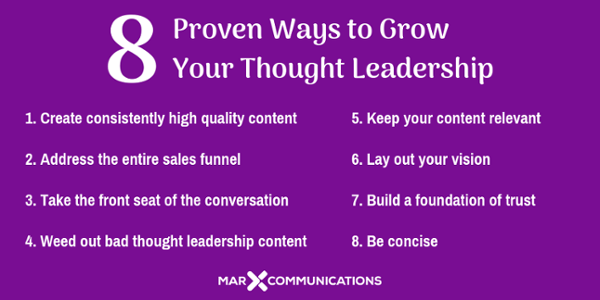
B2B thought leadership does take time and effort — but it is an investment with rich rewards. Take the time to do it right, creating content that resonates with your audience and positively impacts your bottom line.
Business & Finance Articles on Business 2 Community
(56)

